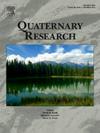帕拉莫的人为活动引发了热带安第斯湖泊的生态变化
IF 1.8
3区 地球科学
Q3 GEOGRAPHY, PHYSICAL
引用次数: 0
摘要
摘要充分了解人类活动对高海拔热带水生生态系统的影响是养护和保护热带安第斯生物多样性热点的关键。我们展示了对厄瓜多尔联合国教科文组织生物圈保护区El Cajas国家公园安第斯山脉高海拔地区湖泊沉积物的多因素研究结果。主要地点Laguna Pallacocha以记录由东太平洋高强度降雨异常引发的厄尔尼诺驱动的碎屑洪积层而闻名。第二个地点,Laguna El Ocho,不包含碎屑叠层,提供了控制。记录显示,约公元1991年,两个高海拔安第斯湖泊中的硅藻组合发生了突然变化,伴随着páramo成分的局部变化,这表明环境中的营养物质突然富集。Laguna Pallacocha的硅藻组合与碎屑输入事件有关,非常稳定,在分析的分辨率下没有显示出明显的厄尔尼诺信号。根据与未受污染的El Ocho记录的比较,我们推断出这种营养富集的主要来源是修建了一条穿过公园的交通繁忙的道路,而气候变暖通过放大其影响起到了次要作用。本文章由计算机程序翻译,如有差异,请以英文原文为准。
Anthropogenic activities in the páramo trigger ecological shifts in Tropical Andean lakes
Abstract A robust understanding of the impact of anthropogenic activities on high-altitude tropical aquatic ecosystems is key for the conservation and protection of the Tropical Andean biodiversity hot spot. We present the results of a multiproxy study of lake sediments from the high Andean páramo of El Cajas National Park, a UNESCO biosphere reserve in Ecuador. The main site, Laguna Pallcacocha, is well known for recording El Niño–driven clastic flood layers that are triggered by high-intensity rainfall anomalies from the eastern Pacific. The second site, Laguna El Ocho, does not contain clastic laminations, providing a control. The records show abrupt shifts in diatom assemblages ca. AD 1991 in both high-elevation Andean lakes accompanied by local changes in páramo composition that suggest a sudden nutrient enrichment of the environment. The diatom assemblages from Laguna Pallcacocha, in relation to the clastic input events, are remarkably stable and do not show evident El Niño signals at the analysed resolution. Based on comparison with the nonlaminated El Ocho record, we deduce the main source of this nutrient enrichment to be the construction of a heavily transited road that runs through the park, while climate warming played secondary role by amplifying its effects.
求助全文
通过发布文献求助,成功后即可免费获取论文全文。
去求助
来源期刊

Quaternary Research
地学-地球科学综合
CiteScore
4.70
自引率
8.70%
发文量
57
审稿时长
3 months
期刊介绍:
Quaternary Research is an international journal devoted to the advancement of the interdisciplinary understanding of the Quaternary Period. We aim to publish articles of broad interest with relevance to more than one discipline, and that constitute a significant new contribution to Quaternary science. The journal’s scope is global, building on its nearly 50-year history in advancing the understanding of earth and human history through interdisciplinary study of the last 2.6 million years.
 求助内容:
求助内容: 应助结果提醒方式:
应助结果提醒方式:


